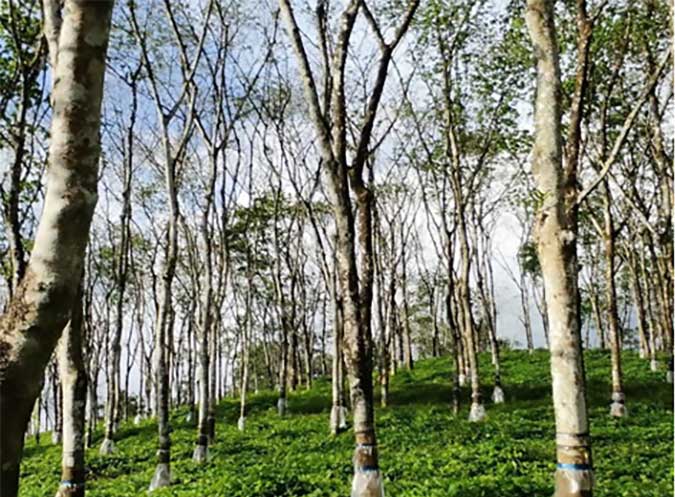Opinion
A fungal disease threatens rubber cultivations in high rainfall areas

By Emeritus Professor Asoka Nugawela
(Former Director, Rubber Research Institute of Sri Lanka)
A new addition to the list of economically important diseases affecting natural rubber cultivations in the country is Circular Spot Leaf Disease (CLSD). It is also known as Pestalotiopsis Leaf Disease (PLD). This fungal disease was first reported in Sri Lanka in 2019 and by 2021 it had spread to around 20,000ha. Currently the affected extent is much higher. The disease severity is found to be more in rubber growing areas receiving a high annual rainfall with a higher number of wet days (Fig. 1). As per the rubber growers in such wet areas the new disease has caused around 30% loss in rubber production. Further the disease has also retarded the growth of young rubber plants. These situations are despite of the disease management programs undertaken incurring high costs. The rubber growers also fear that if this disease continues leading to secondary leaf fall the rubber plantations will become very weak leading to uneconomical rubber yields and poor growth rates in young rubber cultivations. Prolonged immature periods will result in high capital costs and lower the return on investments. At national level the rubber production will decline compelling the rubber product manufacturing sector of the country to import this raw material using scarce foreign exchange. The national rubber production has declined by nearly 6,000 MT from 2021 to 2022. The value of this production loss in 2022 is around 12 million US$.
Disease management
Based on research conducted by the Rubber Research Institute of Sri Lanka two of fungicides are currently recommended for the management of the disease. In the initial interim recommendation of the institute, the concentration of the fungicides is 3 g/ml per liter of water. Subsequently it was increased up to 5 and then again to 10 g/ml expecting to get a better control. In addition to the chemical control, the necessity to adhering into other important agronomic practices such as soil management, weed management, fertilizer application and harvesting is emphasized to enhance growth vigor and disease resistance of the trees.
High costs of the chemicals, spraying of the fungicides to cover the entire canopy of the tall rubber trees and continuous wet weather prevalent in traditional rubber growing areas are some constraints faced by the growers to adopt the chemical control of the disease. After application of the fungicides at least a 5-hour dry period is needed to prevent chemicals getting washed away.
Disease severity
It is clearly evident that since the first appearance of the disease in 2019, the disease severity has shown an increasing trend especially in the relatively more wet rubber growing areas. This is true in both young and mature rubber cultivations. Generally, in mature rubber the full quantum of leaves is present soon after re-foliation in March/April each year. Subsequently with the onset of monsoonal rains the disease incidence take place leading to leaf fall. Disease severity surveys undertaken by a particular plantation management company managing around 3,000 ha of mature rubber in the wetter region clearly shows the progression of the disease since its first detection (Table 1). Surveys had been undertaken in the month of December in each year prior to the onset of wintering.
Out of the total tapping blocks only 21% showed 76 to 100% secondary leaf fall by December 2020. However, in December 2022 this figure was 67%. Hence certain tapping blocks have shown more than 76% defoliation for three consecutive years which will invariably lead to the weaking of such trees leading to less growth and crop production. (See Table 1)
Impact on rubber production
The trend in land productivity of rubber plantations located in the relatively dry and wetter regions managed by this company reveal the impact of CLCD/PLD on the rubber production. Whilst the land productivity shows a gradual increasing trend in the relatively dry regions where the disease is not prevalent, it declines significantly in the wetter region. In both drier and wetter regions, the agricultural practices adopted are similar. Hence it is apparent that CLSD/PLD has led to around 30 to 35 % decline in rubber production in the disease affected areas (Table 2). This decline in rubber production could increase further in the coming years if the disease persists leading to secondary leaf fall. It should be stated that in the financial year 21/22 there were reasons other than CLSD/PLD to lower the land productivity. (See Table 2)
Interventions needed
As shown previously, the severity of the disease, is in an increasing trend since the initial year of infection. The significant negative impact on latex production and growth of young rubber plants are a serious threat to the sustainability of the rubber cultivations in the country, financial performance of investors/growers and the national economy. The potential consequences to the growers, investors and to the economy of the country is too significant for this issue challenging the industry to be taken lightly. Hence the government should be mindful of the consequences of this problem faced by the industry and extend its fullest corporation to the relevant government institutions and departments to come out with suitable a solution. The main strategies to be considered in combating this disease are chemical control methods which includes effective chemicals and application methods, identifying resistance varieties/clones, developing mixed cropping systems, agroecological zoning for crops and escaping from the disease by promoting growing of rubber in regions of the country where this disease is not prevalent to the extent to make rubber cultivations uneconomical.